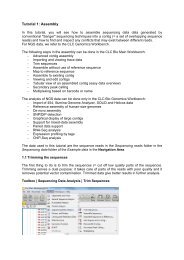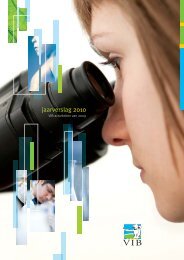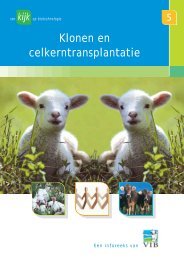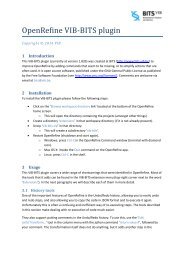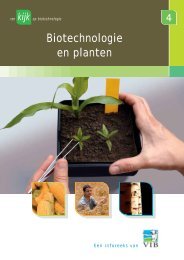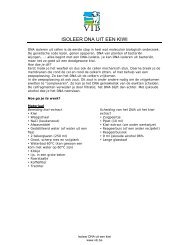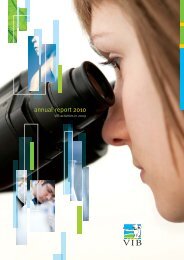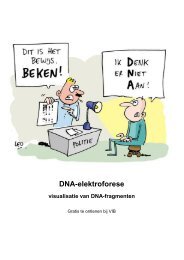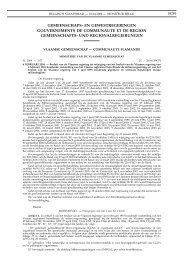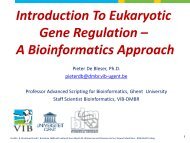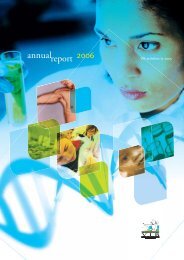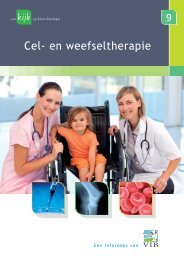Biosafety in the laboratory - VIB
Biosafety in the laboratory - VIB
Biosafety in the laboratory - VIB
Create successful ePaper yourself
Turn your PDF publications into a flip-book with our unique Google optimized e-Paper software.
Def<strong>in</strong>ition of a GMO<br />
GMOs are organisms whose genetic material has been altered <strong>in</strong> a way that<br />
is not possible by reproduction or natural recomb<strong>in</strong>ation. Techniques that<br />
lead to <strong>the</strong> formation of a GMO <strong>in</strong>clude:<br />
*recomb<strong>in</strong>ant-DNA- and RNA-techniques <strong>in</strong>volv<strong>in</strong>g <strong>the</strong> use of host/vector<br />
systems<br />
* techniques <strong>in</strong>volv<strong>in</strong>g <strong>the</strong> direct <strong>in</strong>troduction <strong>in</strong>to a micro-organism of<br />
heritable material prepared outside <strong>the</strong> micro-organism, <strong>in</strong>clud<strong>in</strong>g micro<strong>in</strong>jection,<br />
macro-<strong>in</strong>jection and micro-encapsulation<br />
* cell fusion or hybridisation techniques where liv<strong>in</strong>g cells conta<strong>in</strong><strong>in</strong>g new<br />
comb<strong>in</strong>ations of heritable genetic material are formed through <strong>the</strong> fusion<br />
of two or more cells by means of methods that do not occur naturally<br />
The follow<strong>in</strong>g techniques are not considered to result <strong>in</strong> genetic modification,<br />
on condition that <strong>the</strong>y do not <strong>in</strong>volve <strong>the</strong> use of recomb<strong>in</strong>ant-DNA<br />
molecules or genetically modified organisms<br />
* <strong>in</strong>-vitro fertilisation<br />
* natural processes such as: conjugation, transduction, viral <strong>in</strong>fection,<br />
transformation<br />
* polyploidy <strong>in</strong>duction.<br />
Exceptions to <strong>the</strong> guidel<strong>in</strong>es<br />
The follow<strong>in</strong>g GMOs are excluded from <strong>the</strong> regulations and also from <strong>the</strong> scope of this<br />
booklet if <strong>the</strong>y have been made us<strong>in</strong>g <strong>the</strong> techniques listed below, on <strong>the</strong> condition that<br />
<strong>the</strong>y do not <strong>in</strong>volve <strong>the</strong> use of recomb<strong>in</strong>ant-nucleic acid molecules or GMOs o<strong>the</strong>r than<br />
those produced by one or more of <strong>the</strong> techniques listed below:<br />
* Mutagenesis.<br />
* Cell fusion (<strong>in</strong>clud<strong>in</strong>g protoplast fusion) of prokaryotic species that exchange genetic<br />
material by known physiological processes.<br />
* Cell fusion (<strong>in</strong>clud<strong>in</strong>g protoplast fusion) of cells of any eukaryotic species, <strong>in</strong>clud<strong>in</strong>g<br />
production of hybridomas and plant cell fusions.<br />
* Self-clon<strong>in</strong>g consist<strong>in</strong>g <strong>in</strong> <strong>the</strong> removal of nucleic acid sequences from a cell of an organism<br />
which may or may not be followed by re<strong>in</strong>sertion of all or part of that nucleic acid<br />
(or a syn<strong>the</strong>tic equivalent) with or without prior enzymatic or mechanical steps, <strong>in</strong>to<br />
cells of <strong>the</strong> same species or <strong>in</strong>to cells of phylogenetically closely related species which<br />
can exchange genetic material by natural physiological processes where <strong>the</strong> result<strong>in</strong>g<br />
micro-organism is unlikely to cause disease to humans, animals or plants. Self-clon<strong>in</strong>g<br />
may <strong>in</strong>clude <strong>the</strong> use of recomb<strong>in</strong>ant vectors with an extended history of safe use <strong>in</strong> <strong>the</strong><br />
particular microorganisms.<br />
Recomb<strong>in</strong>ant-DNA GMO’s<br />
Today a whole range of organisms can already be genetically modified, a.o bacteria, yeasts,<br />
fungi, <strong>in</strong>sects (fruit fly), parasites, nematodes, plants, frogs, mammals (mice, rats, rabbits,<br />
goats, sheep, pigs, cattle). Genetic modification <strong>in</strong> general <strong>in</strong>volves <strong>the</strong> follow<strong>in</strong>g components:<br />
Classification and risk assessment 11



